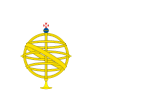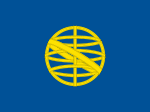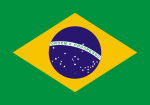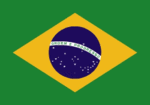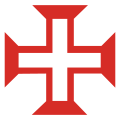- Flag of Brazil
-
Flag of Brazil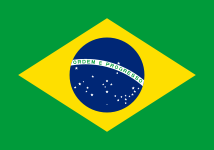
Use National flag and ensign 

Proportion 7:10 Adopted November 19, 1889 (21-star version)
May 11, 1992 (27-star version)
Design A blue disc depicting a starry sky spanned by a curved band inscribed with the national motto, within a yellow rhombus, on a green field. Designed by Raimundo Teixeira Mendes The national flag of Brazil (Portuguese: Bandeira do Brasil) is a blue disc depicting a starry sky spanned by a curved band inscribed with the national motto, within a yellow rhombus, on a green field. Brazil officially adopted this design for its national flag on November 19, 1889, replacing the flag of the second Empire of Brazil. The concept was the work of Raimundo Teixeira Mendes, with the collaboration of Miguel Lemos, Manuel Pereira Reis and Décio Villares.
The green field and the yellow rhombus from the previous imperial flag were preserved – the green and yellow colors representing the Braganza-Habsburg dynasty.[1] A blue circle with 27 white five-pointed stars replaced the arms of the Empire of Brazil. The stars, whose position in the flag reflect the sky over Rio de Janeiro on November 15, 1889, represent the union's federated units – each star representing a specific state. The motto "Ordem e Progresso" ("Order and Progress") is inspired by Auguste Comte's motto of positivism: "L’amour pour principe et l’ordre pour base; le progrès pour but" ("Love as a principle and order as the basis; progress as the goal").[2]
Contents
History
Colonial Brazil (1500–1816)
The Portuguese territories in the Americas, corresponding roughly to what is now Brazil, never had their own official flag, since the Portuguese tradition was to hoist the flag of the Kingdom of Portugal in all territories of the Portuguese Crown.
The first Brazilian vexillological symbols were private maritime flags used by Portuguese merchant ships that sailed to Brazil. A flag with green and white stripes was used until 1692.[3] The green and white colors represented the House of Braganza and the national colors of Portugal. In 1692, that flag was no longer used by ships that sailed to Brazil and became the flag of the merchant vessels in coastal Portugal. In 1692, a new flag was introduced for merchant vessels sailing to Brazil. The new flag had a white field with a golden armillary sphere. The armillary sphere was the personal emblem of King Manuel I. During his reign it was widely used by Portuguese ships, and eventually became a national emblem of Portugal and, more specifically, the Portuguese empire. A similar flag was introduced for the Portuguese ships that sailed to India, but with a red armillary sphere. Despite representing the entire Portuguese empire, the armillary sphere began to be used more extensively in Brazil – the largest and most developed colony at the time – not only in maritime flags, but also on coins and other media. It eventually became the unofficial ensign of Brazil.
Kingdom of Brazil (1816–1822)
In 1815, Brazil was elevated to the rank of kingdom, and the kingdoms of Portugal, Brazil and the Algarves were united as a single state – the United Kingdom of Portugal, Brazil and the Algarves. The Charter Act of 1816 established the insignia of the new kingdom.[4] It specified that the arms of the Kingdom of Brazil was to be composed of a gold armillary sphere on a blue field.[4]
Empire of Brazil (1822–1889)
The imperial flag of Brazil was designed by Jean-Baptiste Debret as the Royal Standard of the Prince Royal of the United Kingdom of Portugal, Brazil and the Algarves, Pedro I.
After the Brazilian Declaration of Independence, and with the coronation of Pedro I as Emperor of Brazil, the Royal Standard was modified to become the flag of the Empire of Brazil. The new flag featured the imperial coat of arms within a yellow rhombus, on a green field.[5] The green and yellow colors represented the dynastic houses of Pedro I and his consort Maria Leopoldina of Austria.[2]
The imperial flag was slightly modified during the reign of Pedro II, when an extra star was added to the imperial arms to conform to the new territorial organization of the country.
Republic of Brazil (1889–)
Upon the proclamation of the Republic, one of the civilian leaders of the movement, the lawyer Ruy Barbosa, proposed a design for the nation's new flag strongly inspired by the flag of the United States. It was flown from November 15, 1889, until November 19, 1889, when Marshal Deodoro da Fonseca – acting as provisional president of Brazil – vetoed the design, citing concerns that it looked too similar to the flag of another state.[6]
Fonseca suggested that the flag of the new republic should resemble the old imperial flag.[6] This was intended to underscore continuity of national unity during the transition from a constitutional monarchy to a republic.[6] Raimundo Teixeira Mendes presented a project in which the imperial coat of arms was replaced by a blue celestial globe and the positivist motto. It was presented to Fonseca, who promptly accepted. The flag was designed by a group formed by Raimundo Teixeira Mendes, Miguel Lemos, Manuel Pereira Reis and Décio Villares.[7] It was officially adopted on November 19, 1889.[8]
On May 12, 1992, the flag was modified with the addition of six stars to the celestial globe – representing the newly created states, and a slight change in the stars' positions was made to match the astronomical coordinates correctly.
Design
The decree no. 4, issued on November 19, 1889, legally replaced the flag used under the constitutional monarchy with the new national flag.[9] On May 11, 1992, the law no. 8,421, altered the celestial globe with the addition of six stars.[9]
Construction
The official design of the Brazilian Flag is defined by law no. 5,700, issued on September 1, 1971.[10] The flag's length is twenty modules and the width, fourteen, translating into an aspect ratio of 7:10. The distance of the vertices of the yellow rhombus to the outer frame is a module and seven-tenths (1.7m). The blue circle in the middle of the yellow rhombus has a radius of three and a half modules (3.5m). The center of the arcs of the white band is two modules (2m) to the left of the meeting point of the extended vertical diameter of the circle with the base of the outer frame. The radius of the lower arc of the white band is eight modules (8m) and the radius of the upper arc of the white band is eight and a half modules (8.5m). The width of the white band is a half of a module (0.5m).
The caption "Order and Progress" is written in green letters. The letter P lies on the vertical diameter of the circle. The letters of the word "Order" and the word "Progress" are a third of a module (0.33m) tall. The width of these letters are three-tenths of a module (0.30m). The conjunction E has a height of three-tenths of a module (0.30m) and a width of a quarter of a module (0.25m).
The stars are of five different sizes: first, second, third, fourth and fifth magnitudes. They are drawn within circles whose diameters are: three-tenths of a module (0.30m) for the first magnitude, a quarter of a module (0.25 m) for the second magnitude; a fifth of a module (0.20m) for the third magnitude, a seventh of a module (0.14m) for the fourth magnitude, and a tenth of a module (0.10m) for the fifth magnitude.
Stars
Professor Paulo Araújo Duarte of the Federal University of Santa Catarina, bears this out, saying "In truth, the creators of our republican flag intended to represent the stars in the sky at Rio de Janeiro at 8:30 in the morning on 15 November 1889, the moment at which the constellation of the Southern Cross was on the meridian of Rio de Janeiro and the longer arm [of the cross] was vertical." Another article, citing "O Céu da Bandeira (The Sky of the Flag)", by J.R.V. Costa, says the exact time was actually 08:37. This last article includes the designer of the flag's explanation of his intentions regarding the stars.
According to Brazil's national act number 5,700 of 1 September 1971, the flag portrays the stars as they would be seen by an imaginary observer an infinite distance above Rio de Janeiro standing outside the firmament in which the stars are meant to be placed. Thus Beta Crucis appears to the right of the constellation and Delta Crucis to the left, in mirror image of the way they actually appear in the sky (and, coincidentally, the way they appear on the Brazilian coat of arms).
The star Spica is the only one above of the white band, it symbolizes part of Brazilian territory in the northern hemisphere (and the State of Pará).
The Sigma Octantis (south pole star) is small, but all the other stars turn around it, the only position in the sky of south hemisphere represents the stability of the Federal District in the Brazilian Union.
The shining star in constellation represent the size of territory of the State in the Brazilian region (constellation).
The flag of Brazil contains 27 stars representing the Brazilian states and the Federal District.[11] The constellation of the Southern Cross is on the meridian (indicated by the number 6 in the diagram). To the south of it is Polaris Australis (Sigma Octantis, numbered 7), representing the Federal District. The motto appears on a band roughly coincident with the ecliptic. A single star lies above the band, representing the large northern state of Pará, which straddles the Equator.
A list of constellations and stars on the map:
- Procyon (α Canis Minoris),
- Canis Major, with the largest star depicting Sirius,
- Canopus (α Carinae),
- Spica (α Virginis)
- Hydra
- Crux Australis
- Sigma Octantis (σ Octantis; south pole star)
- Triangulum Australe
- Scorpius, with the largest star depicting Antares
The stars depicted on the flag and the states they represent are:[11]
State Star Constellation Size
(1=largest)Amazonas Alpha Canis Minoris (Procyon) Canis Minor, the Little Dog 1 Mato Grosso Alpha Canis Majoris (Sirius) Canis Major, the Great Dog 1 Amapá Beta Canis Majoris (Mirzam) Canis Major, the Great Dog 3 Rondônia Gamma Canis Majoris (Muliphen) Canis Major, the Great Dog 4 Roraima Delta Canis Majoris (Wezen) Canis Major, the Great Dog 2 Tocantins Epsilon Canis Majoris (Adhara) Canis Major, the Great Dog 2 Pará Alpha Virginis (Spica) Virgo, the Virgin 1 Piauí Alpha Scorpii (Antares) Scorpius, the Scorpion 1 Maranhão Beta Scorpii (Graffias) Scorpius, the Scorpion 3 Ceará Epsilon Scorpii Scorpius, the Scorpion 2 Alagoas Theta Scorpii (Sargas) Scorpius, the Scorpion 2 Sergipe Iota Scorpii Scorpius, the Scorpion 3 Paraíba Kappa Scorpii Scorpius, the Scorpion 3 Rio Grande do Norte Lambda Scorpii (Shaula) Scorpius, the Scorpion 2 Pernambuco Mu Scorpii Scorpius, the Scorpion 3 Mato Grosso do Sul Alpha Hydrae (Alphard) Hydra, the Water Serpent 2 Acre Gamma Hydrae Hydra, the Water Serpent 3 São Paulo Alpha Crucis ( Star of Magalhães) Crux, the Southern Cross 1 Rio de Janeiro Beta Crucis (Mimosa) Crux, the Southern Cross 2 Bahia Gamma Crucis (Rubídea) Crux, the Southern Cross 2 Minas Gerais Pálida Crux, the Southern Cross 3 Espírito Santo Epsilon Crucis Crux, the Southern Cross 4 Rio Grande do Sul Alpha Trianguli Australis Triangulum Australe, the Southern Triangle 2 Santa Catarina Beta Trianguli Australis Triangulum Australe, the Southern Triangle 3 Paraná Gamma Trianguli Australis Triangulum Australe, the Southern Triangle 3 Goiás Alpha Carinae (Canopus) Carina, the Keel of Argo 1 Distrito Federal Sigma Octantis (Polaris Australis) Octans, the Octant 5 Colors
The flag's colors are not accurately specified in any legal document. Approximate colours are listed below[12]:
Green Yellow Blue White RGB 0/168/89255/204/4162/64/149255/255/255Hexadecimal 00A859FFCC293E4095FFFFFFCMYK 100/0/100/00/20/100/0100/100/0/00/0/0/0Flag protocol
The federal law no. 5,700, issued on September 1, 1971, defines the flag protocol in Brazil.[13][14] The flag must be permanently hoisted at the Praça dos Três Poderes in Brasília. The flag must be raised and lowered daily at the presidential palaces (Palácio do Planalto and Palácio da Alvorada); ministries; National Congress; Supreme Federal Tribunal; Supreme Court of Justice; seats of the Executive, Legislative and Judicial branches; diplomatic missions; Federal, state and local institutions; and merchant navy units. When a flag is no longer fit to use, it must be delivered to a military facility to be burned during a special ceremony on November 19 ("Flag Day").
The flag must be flown at half-staff when the President decrees official mourning. In addition, state and local governments may decree official mourning with the death of a Mayor or Governor. When the flag is displayed at half-staff, prior to raising or lowering it, the flag must be raised to the top of the flagpole and then lowered to the halfway mark. When the flag is being carried in procession, a black crape ribbon must be tied to the top of the mast.
Foreign flags may only be flown with a Brazilian Flag along its right side. The only exceptions are when the foreign flag is displayed in an embassy or consulate and in prizing ceremonies of sport competitions won by foreign athletes. When multiple flags are raised or lowered simultaneously, the Brazilian Flag must be the first to reach the top of the flagpole and the last to reach the bottom.
Folding
Stage Description Example First The upper half of the flag's height is folded into the reverse side. Second The folding proceeds by folding the flag's lower half into the reverse side until most of the blue disc and the motto face up. Third The flag is then folded into three parts along the width axis, with the fly and hoist folded into the reverse side, leaving the blue disc and motto facing up.
Flag anthem
The Brazilian Flag Anthem (Hino à Bandeira Nacional), is a hymn dedicated to the country's flag. It is performed on November 19 (Flag Day). The lyrics were written by poet Olavo Bilac, and the music composed by Francisco Braga.[16]
The Hino à Bandeira Nacional[16] Salve lindo pendão da esperança!
Salve símbolo augusto da paz
Tua nobre presença à lembrança
A grandeza da Pátria nos traz.
Chorus
Recebe o afeto que se encerra
em nosso peito juvenil,
Querido símbolo da terra,
Da amada terra do Brasil!
Em teu seio formoso retratas
Este céu de puríssimo azul,
A verdura sem par destas matas,
E o esplendor do Cruzeiro do Sul.
(Chorus)
Contemplando o teu vulto sagrado,
Compreendemos o nosso dever,
E o Brasil por seus filhos amado,
poderoso e feliz há de ser!
(Chorus)
Sobre a imensa nação brasileira,
Nos momentos de festa ou de dor,
Paira sempre sagrada bandeira,
Pavilhão da justiça e do amor!
(Chorus)Translation: Brazilian Flag Anthem Hail, precious banner of hope!
Hail, august symbol of peace!
Thy noble presence to our minds
The greatness of our motherland does bring.
Chorus
Take the affection enclosed
In our youthful chest,
Dear symbol of the land,
Of the beloved land of Brazil!
In thy beauteous bosom portraits
This sky of purest blue,
The unrivalled greenness of these forests,
And the splendor of the Southern Cross.
(Chorus)
Beholding thy sacred shadow,
We understand our duty,
And Brazil loved by its children,
Powerful and happy shall be!
(Chorus)
Over the great Brazilian Nation,
In times of happiness or grief,
Hovers always the sacred flag,
Pavilion of justice and love!
(Chorus)Other flags
The Brazilian naval jack (jaque) is a rectangular flag (ratio 3:4) bearing 21 white stars on a dark blue field – a horizontal row of 13 and a vertical column of 9, orthogonally displayed. [17]
Governmental flags
The president and vice president are also represented by their own flag.[18] The Presidential Standard is a dark green rectangle (ratio 2:3) holding the national coat of arms on its center. It is usually hoisted at the President's official residence, the Palácio da Alvorada, and at the President's workplace, the Palácio do Planalto. It is also displayed on the presidential car, as small-sized flags. The Vice Presidential Standard is a yellow rectangle (ratio 2:3) with twenty-three blue stars disposed in a cross dividing the flag into four equal quadrants, with the coat of arms in the middle of the upper left quadrant.
Previous flags
The list below identifies previous flags used in Brazil.[19]
-
Flag of the Military Order of Christ (1332–1651)
-
Flag of the Royal Family (1500–1521)
-
Flag of Dom John III (1521–1616)
-
Flag of the Iberian Union (1616–1640)
-
Flag of the Restoration (1640–1683)
-
Flag of the Principality of Brazil (1645–1816)
-
Flag of Dom Peter II (1683–1706)
-
Flag of Dom John V (1707–1750)
-
Flag of the United Kingdom of Portugal, Brazil and the Algarves (1816–1821)
Rejected flags
The best known rejected flags are listed below.[20]
-
Project of Júlio Ribeiro, 1888. Eventually became the flag of the State of São Paulo.
See also
References
- ^ The World Factbook: Brazil – Flag description CIA. Retrieved on 2010-10-08.
- ^ a b Bandeiras e significados Historianet. Retrieved on 2010-10-09. (Portuguese).
- ^ Bandeiras navais Portuguesas Associação Nacional de Cruzeiros. Retrieved on 2010-10-09. (Portuguese).
- ^ a b Carta de Lei de 13 de Maio de 1816 John Carter Brown Library. Retrieved on 2010-10-09.
- ^ Decreto de D. Pedro I de 18 de setembro de 1822 Wikisource. Retrieved on 2010-10-09. (Portuguese).
- ^ a b c Um estudo histórico perceptual: A Bandeira Brasileira sem Brasil Seysell, Ricardo. Universidade Estadual Paulista), 2006. Retrieved on 2010-10-10. (Portuguese).
- ^ Designers of the Flag Flags of the World. Retrieved on 2010-10-08.
- ^ Símbolos Nacionais Exército Brasileiro. Retrieved on 2010-10-08. (Portuguese).
- ^ a b Símbolos e Hinos: Bandeira Nacional Brasil.gov.br. Retrieved on 2010-10-09. (Portuguese).
- ^ Law on the National Flag: details of construction Flags of the World. Retrieved on 2010-10-08.
- ^ a b Duarte, Paulo Araújo. "Astronomia na Bandeira Brasileira". Universidade Federal de Santa Catarina. http://www.cfh.ufsc.br/~planetar/textos/astroban.htm. Retrieved 2009-07-09.
- ^ "Brazilian flag". http://www.presidencia.gov.br/presidenta/simbolos-nacionais/Bandeira%20do%20Brasil%20cdr.zip.
- ^ Uso da Bandeira Nacional Brasil República. Retrieved on 2009-06-15. (Portuguese).
- ^ Lei no. 5,700 de 1 de Setembro de 1971 Presidência da República. Retrieved on 2010-10-09. (Portuguese).
- ^ Hino à Bandeira Nacional – Coral (Exército Brasileiro) Dominiopublico.gov.br. Retrieved on 2010-10-10. (Portuguese).
- ^ a b Hino à Bandeira Nacional Exército Brasileiro. Retrieved on 2010-10-10. (Portuguese).
- ^ Cerimonial da Marinha Marinha do Brasil. Retrieved on 2010-10-09. (Portuguese)
- ^ President and Vice President (Brazil) Flags of the World. Retrieved on 2010-10-09.
- ^ "Bandeiras Históricas do Brasil" (in Portuguese). Exército Brasileiro. http://www.exercito.gov.br/01inst/Historia/bandhist/bandhist.htm.
- ^ Projetos de mudança da Bandeira Nacional Brasileira BrasilRepública. Retrieved on 2010-10-08. (Portuguese).
External links
National symbols of Brazil Official Other Flags of South America Sovereign states Dependencies and
other territoriesNational flags and coats of arms National flags National coats of arms Categories:- Flags of Brazil
- National flags
- National symbols of Brazil
- Southern Cross Flags
Wikimedia Foundation. 2010.

